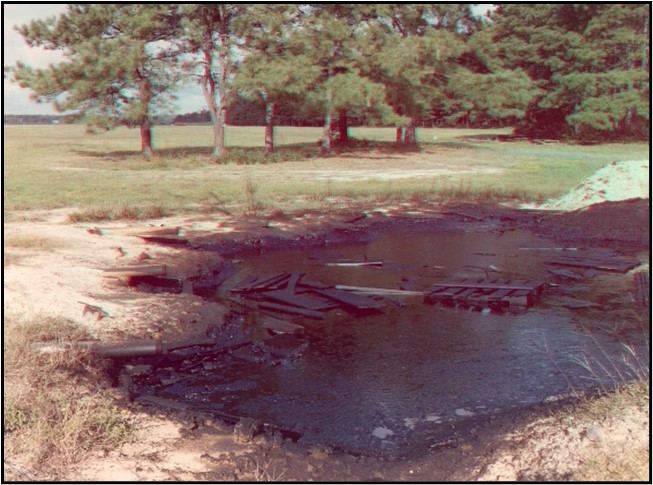Operable Unit 02
Background
Operable Unit 2, the Former Fire Training Area (FFTA) site, was used by NASA for firefighting training exercises from 1965 to 1987. A soil removal action and several environmental investigations have been completed at the site, and groundwater monitoring is ongoing. NASA is currently conducting the third Five-Year Review for the FFTA and Operable Unit 3, the Waste Oil Dump (WOD) site.
NASA encourages the public to review the technical documents below to gain a more comprehensive understanding of activities that have been conducted at the FFTA.
History of the Former Fire Training Area
The FFTA was used by NASA for firefighting training exercises from 1965 to 1987. In 1986, a Virginia Department of Environmental Quality (VDEQ) inspection identified the presence of petroleum-saturated soils at the site. In response, NASA conducted a soil removal action in 1988, removing about 120 cubic yards of soil.
 Stained Soils from 1988 Stained Soils from 1988 |
 Fire Training, 1988 Fire Training, 1988 |
Former Fire Training Area Today
The FFTA is located north of Runway 10-28 and generally consists of an open grass field bounded by trees on the northern and eastern perimeter. Numerous groundwater monitoring wells are dispersed throughout the site.
 Aerial Map of FFTA Location Aerial Map of FFTA Location |
 FFTA Site Picture from 2022 FFTA Site Picture from 2022 |
Previous Investigations
Site Investigation and Remedial Investigation – From 1989 through 1996, NASA completed Site Investigation and Remedial Investigation activities which consisted of soil gas and geophysical surveys, and soil and groundwater sampling and analysis. The results of the investigations identified the elevated presence of solvents, metals, and petroleum-related contamination in the soil and groundwater. Below is a summary of the additional environmental activities completed at the FFTA.
Supplemental Remedial Investigation – From 2000 to 2004, NASA completed additional investigations to fully characterize the nature and extent of groundwater contamination associated with the FFTA. The investigations studied the source areas and defined the nature of the risks posed by the site. The Supplemental Remedial Investigation also determined the FFTA did not present a threat to ecological receptors, however, groundwater contamination presented an unacceptable risk to human health under the future use scenario.
Feasibility Study – In 2005, NASA completed the Feasibility Study to evaluate potential remedial alternatives to address the site risks.
Proposed Remedial Action Plan – In 2007, NASA completed the Proposed Remedial Action Plan which identified biostimulation as the recommended remedial alternative.
Record of Decision – In December 2008, NASA completed the Record of Decision documenting the selected remedy, which included in-situ biostimulation, institutional controls, and monitoring.
Remedial Action Completion Report – NASA implemented a pilot study to evaluate the effectiveness of in-situ biostimulation at the site in December 2008. Results from the study indicated the concentrations of the contaminants were relatively low and, in most cases, too low to be effectively treated with the planned biostimulation injections. Based on those findings, which were presented in the Remedial Action Completion Report, NASA, the U.S. Environmental Protection Agency (USEPA), and VDEQ, agreed to implement quarterly sampling as the long-term monitoring component.
Long-Term Monitoring
Since 2010, NASA has completed groundwater long-term monitoring activities at the FFTA. Over this time, several contaminants of concern (COCs) first established in the ROD have achieved their clean-up goals and have been removed from the monitoring events. These COCs include cis 1,2-dichloroethene, vinyl chloride, benzene, and 4-methylphenol. The COCs currently monitored at the FFTA include naphthalene, arsenic, and manganese. In addition, the monitoring frequencies were reduced from quarterly, to semi-annual, to every nine months, and currently every 15 months to account for seasonal variations. NASA completed the most sampling event in September 2022. The next sampling event is scheduled for December 2023.
Long-Term Monitoring Plan – Revision 4 – In 2022, NASA completed the Long-Term Monitoring Plan Revision 4, which outlines the current sampling methodology and protocols. NASA submits a Data Summary Report to USEPA and VDEQ following each sampling event.
Long-Term Monitoring Data Summary Report – In 2022, NASA completed the Long-Term Monitoring Data Summary Report which documented the groundwater monitoring activities and analytical results from June 2021.
Five-Year Reviews
The Administrative Agreement on Consent requires NASA conduct a review of ongoing remedial actions every five years until EPA issues a Certificate of Completion documenting cleanup standards have been met. The third Five-Year Review is now underway and will evaluate all long-term monitoring data, including per- and polyfluoroalkyl substances (PFAS) and other potential new contaminants of concern. The Review is expected to be available to the community by January 2024. Previous Five-Year Reviews include:
First Five-Year Review – NASA completed this Review, which also included OU 3 Waste Oil Dump site, in 2014. The review indicated PFAS may be present based on historical usage of aqueous film-forming foams (AFFF) in firefighting training exercises. The Review recommended NASA work with USEPA and VDEQ to develop the most appropriate path forward to determine whether groundwater at the FFTA contained PFAS by December 31, 2018. The Review deferred the protectiveness of the remedy until PFAS were evaluated at the site. Visit the Wallops PFAS site for the latest on NASA's ongoing efforts related to PFAS.
Second Five-Year Review – NASA completed this Review in 2019. The Review deferred the protectiveness of the remedy until promulgated regulatory criteria are available to compare to the PFAS concentrations at the FFTA site.
For any questions regarding Operable Unit 02, or NASA WFF's Restoration Program, please contact:
David Liu
Restoration Program Manager
NASA Wallops Flight Facility
Mailstop: 250.W
Wallops Island, VA 23337
david.liu-1@nasa.gov
(757) 824-2141



